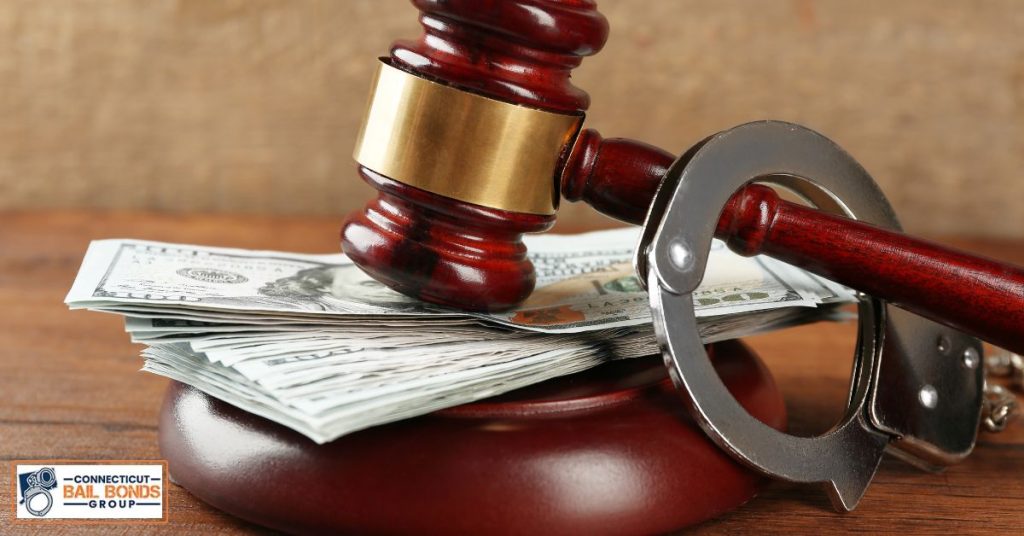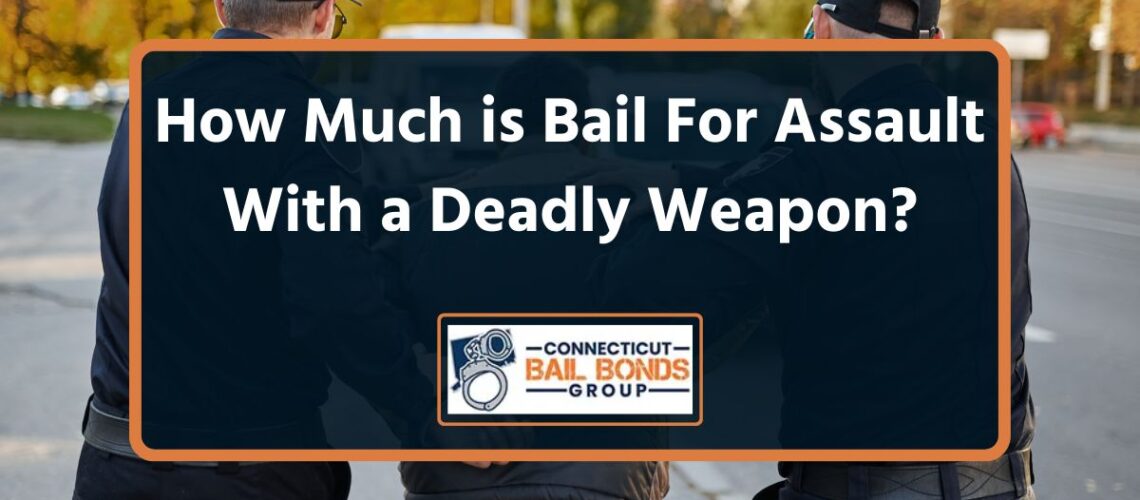Facing an assault with a deadly weapon charge is a serious matter, and understanding the legal system behind it can be complex and confusing.
One important aspect of this process is understanding bail generally. You need to know potential bail amounts and the factors influencing them to prepare yourself or any of your loved ones and make informed decisions.
So, how much is bail for assault with a deadly weapon?
In Los Angeles, California, the standard bail for an assault with a deadly weapon falls between $50,000 and $100,000.
However, the exact bail amount for assault with a deadly weapon can vary widely based on several factors, including the jurisdiction, the specific circumstances of the case, the defendant’s criminal history, and the judge’s discretion.
At Connecticut Bail Bonds, we provide reliable and accessible information about the legal system, particularly concerning bail.
Book a 24/7 free consultation session with any of our professional legal representatives now.
In this article, let us explore the average bail amount for assault with a deadly/dangerous weapon and the factors that may influence the amount.
What is Assault with a Deadly Weapon?

Assault with a deadly weapon is a serious criminal offense involving the threat or use of harm against someone with an object capable of inflicting serious injury or death.
The key elements of assault with a harmful weapon include:
- Intent: The perpetrator must have/show intentions to cause the victim to fear imminent bodily harm or serious physical injury.
- Fear of Harm: The victim must reasonably believe that they are in danger of physical harm.
- Use of a Deadly Weapon: The assault must involve the use of a deadly or harmful weapon, which could be a firearm, knife, blunt object, or any other object capable of causing serious physical injury or death.
Penalties for this type of aggravated assault vary depending on the jurisdiction and the specific circumstances of the offense. Convictions for this crime often result in more severe penalties than simple assault charges.
The legal consequences may include imprisonment, fines, probation, and other criminal penalties, and assault bail bonds may come with some conditions to protect the victim from harassment from the defendant.
Although laws vary by jurisdiction, assault with a dangerous weapon is generally considered a felony assault or offense. The severity of the crime depends on factors like the specific weapon used, the intent of the perpetrator, and the resulting harm to the victim.
Average Bail Amounts for Assault with a Deadly Weapon

Determining a bail amount for assault with a deadly weapon is challenging due to the vast differences across jurisdictions stated above, the specific circumstances of each case, and the judge’s discretion.
For example, in Los Angeles, California, the standard bail for an assault with a deadly weapon falls between $50,000 and $100,000. An aggravated assault with a firearm may reach up to $250,000.
In Texas, Harris County, assault with a deadly weapon may see bail set at $5,000, while aggravated assault with a deadly weapon can range from $25,000 to $50,000.
Based on these examples, the average bail for ADW falls within a broad range of $5,000 to $100,000, with significant variations depending on the factors stated above.
To make your bail bond process easier, get a strong legal representation or a trusted legal bail bond service. Some reputable bail bond companies, such as Connecticut Bail Bonds Group offer easy payment plans to help you bail your loved ones out of jail without breaking the bank.
The Bail Bond Process For Assault With a Deadly Weapon

A bail serves as a financial guarantee that a defendant will appear in court for their scheduled hearings. The bail allows the defendant to secure their freedom while awaiting trial, rather than being in jail.
There are some important things to provide if the defendant is already in jail and wants to bail themselves. Defendants can also post bail through trusted bail bondsmen who charge a non-refundable premium fee for their services.
Here are the steps involved in the bail process:
Arrest and Booking
When a person is arrested for assault with a dangerous weapon, they are taken into custody by law enforcement. The arrested person is then taken to a police station or detention facility where they undergo a booking process.
Initial Court Appearance
The arrested person appears before a judge for an initial court appearance. At this stage, the judge may inform them of the charges against them, advise them of their rights, and set an initial bail amount.
Bail Hearing
During the bail hearing, the judge considers factors such as the severity of the charges, the defendant’s criminal history, ties to the community, and the risk of flight. The judge may set bail at a specific amount, deny bail, or release the defendant on their recognizance without requiring payment of bail.
Bail Amount
If the judge sets a bail amount, the defendant or their family can pay the bail to secure the defendant’s release from custody.
Bail Bonds
If the defendant or their family cannot afford the full bail amount, they may contact a bail bondsman. A bail bondsman typically charges a fee, usually a percentage of the total bail amount, and provides a bond to the court, guaranteeing the defendant’s appearance.
Release
Once the defendant posts bail or secured released from custody. However, it’s important to note that the defendant must still appear in court for all scheduled hearings.
Factors Affecting Bail Amount for Assault with a Deadly Weapon

When determining bail for a defendant charged with assault with a deadly weapon, the court considers several factors. These factors influence the ultimate decision on whether to grant bail and if granted, the amount set.
1. Severity of the Charge
More serious charges, which typically involve greater harm or result in significant injuries to the victim, often lead to higher bail amounts. This reflects the court’s concern for public safety and the threat posed by the defendant.
2. Criminal History
A defendant’s past criminal record of violent offenses, especially involving similar weapons or victims, can lead to a higher bail amount as the court considers it a greater risk of re-offending. Conversely, a clean criminal record may contribute to a lower bail amount.
3. Victim’s Condition and Public Safety
If the victim sustained a serious bodily injury or is at risk of further harm, the court may set a higher bail amount to ensure the victim’s safety and deter the defendant from committing further offenses.
4. Judicial Discretion and Statutory Guidelines
While judges have discretion in setting bail, there are statutory guidelines established by each jurisdiction guiding them.
For instance, the California Penal Code guides the setting of bail and other court conditions in California. These guidelines often specify bail ranges based on the severity of the offense and other relevant factors.
Understanding Your Rights and Responsibilities in the Bail Process
The bail process can be confusing and stressful, especially for people unfamiliar with the legal system. But, understanding your rights and responsibilities as a defendant released on bail is important to ensuring a smooth process and protecting your freedom.
Rights of the Defendant
- Right to a fair bail hearing
- Right to present evidence and witnesses
- Right to an attorney
- Right to know the charges and conditions of bail
- Right to a speedy trial
Responsibilities of the Defendant

- Appear for all court hearings: The defendant must appear for all scheduled court hearings as required by the conditions of their bail.
- Obey all court orders and restrictions: This may include limitations on travel, contact with victims or witnesses, and engagement in certain activities.
- Maintain contact with the bail bondsman: The defendant must keep the bail bondsman informed of any changes in their address or contact information.
- Refrain from criminal activity: Engaging in any criminal activity while on bail can lead to bail revocation and imprisonment.
- Pay bail bond fees and premiums: The defendant must fulfill their financial obligations to the bail bondsman according to the agreed terms.
Alternatives to Bail and Bail Reform
The concept of bail, while long-established, has faced increasing scrutiny in recent years. Critics argue that the bail system disproportionately impacts low-income individuals, creating a “wealth-based detention” system where those who can afford bail get freedom while others languish in jail awaiting trial.
Bail bonds allow defendants to secure release by paying a percentage of the entire bail amount. While offering a solution for those who cannot afford the full sum, the system can be exploitative, with high fees and collateral requirements further straining defendants’ financial resources.
Fortunately, innovative alternatives are emerging, driven by the ongoing movement for bail reform:
- Release on Own Recognizance (ROR)
- Unsecured Bail
- Supervised Release
- Citation Release
- Signal Systems
Conclusion
No matter the complexity of your case or the severity of the offense, one thing always stand out: you need expert counsel to navigate the bail process.
At Connecticut Bail Bonds, we are always ready to assist you to secure fast and affordable release from jail for you or your loved ones.
Our team of experienced legal professionals provide comprehensive guidance, support, and other needed legal bail bond services throughout the bail process, helping you secure the best possible outcome. Reach out to us today for a free consultation.


